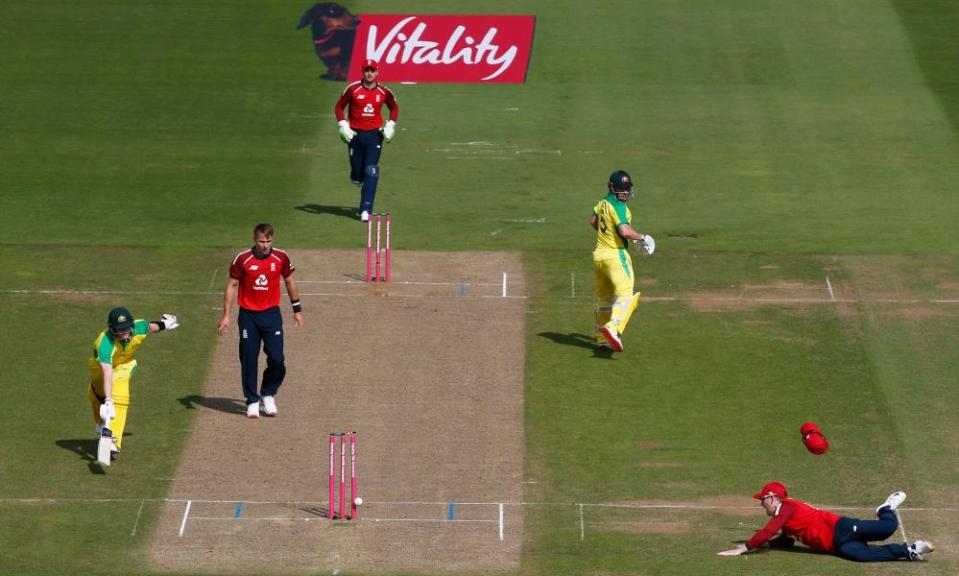Jos Buttler shows class to seal England's T20 series win against Australia

Jos Buttler delivered a glorious demonstration of how to pace a run chase. The target, 158, was not formidable but, as the Australians are all too aware, such middling scores can be tricky to overhaul. But with Buttler at the crease there was no slip-up. He purred to an unbeaten 77 from 54 balls and finished the match with seven deliveries to spare with a straight six off Adam Zampa that cleared the boundary by about 40 yards. So England won the game by six wickets and have taken the series; if they win the final game on Tuesday evening they overtake Australia as the No 1 T20 side in the ICC’s rankings table.
Afterwards Eoin Morgan affirmed that he would play the best XI for the final game having hailed “a better bowling performance. Jofra [Archer] set the tone in that first over and when you’ve got a world-class player like Jos Buttler in form it makes the chase easier.” Unsurprisingly Buttler will stay at the top of the order for the moment and the man himself acknowledged afterwards “it’s the best place to bat in T20 cricket and my favourite position but I’m happy to bat anywhere. It’s up to the captain and coach.”
Related: England beat Australia by six wickets in second men's Twenty20 – as it happened
England dominated the match throughout. They bowled very fast and very well at the start. Archer’s first over was sensational. The ball whistled through leaping off the pitch; the third one jagged back into David Warner, who was given out caught behind by umpire Mike Burns; curiously Warner reviewed but the replay revealed that the ball had brushed his glove.
Mark Wood bowled at a similar pace, too fast for newly promoted Alex Carey, who edged more conventionally to the keeper. So Australia were three for two after two overs. At one point Morgan stationed three slips and a gully for Archer and this seemed more like a good idea than an impudent gesture.
Aaron Finch and Steve Smith began the recovery with both of them hitting massive leg-side sixes against 90mph deliveries; this was red-blooded cricket. Then at the end of the fifth over Smith called for an ambitious single and Morgan’s throw from mid-on hit the stumps and the batsman just kept running towards the pavilion.

From 30 for three Australia did well to reach 157 for seven. Finch was often starved of the strike but the odd flick off the hip and a straight six off Adil Rashid, who bowled another fine spell, allowed Australia to advance. Then both Finch and the dangerous Marcus Stoinis departed in consecutive overs.
Glenn Maxwell, Ashton Agar and Pat Cummins scurried to complete the recovery. Archer’s final over, which yielded 18 runs and included the only wides of the innings, was not as good as his first one. Nonetheless, there was a welcome buoyancy to his performance as there was to England’s display in general. Genuine pace plus beguiling wrist spin must have provided a fine spectacle for the enlarged TV audience.
England’s response was measured rather than explosive. Finch took the precaution of giving Mitchell Starc and Cummins five of the six powerplay overs to enhance his chances of keeping control. Jonny Bairstow departed in an unusual fashion, which often happens to batsmen short of runs. He tried a pull against Starc and missed the ball by a considerable margin but as he completed the shot his bat flicked the top of the stumps. In the tell-tale era of flashing stumps and bails there could be no escape for Bairstow: hit wicket, bowled Starc.
Now England’s form batsmen united. Buttler has long been a reassuring presence against a white ball but in the space of only 15 matches Dawid Malan, drawing on his long experience in the T20 Blast for Middlesex and in the Pakistan Super League, increasingly prompts confidence. He appears to take his time; like all the best players he tries to minimise risk and yet his strike rate hovers around 150 in international T20 cricket. He did not go that fast on Sunday but he did not need to.
Initially Malan outpaced Buttler as the pair added 87. Then Malan’s pull-drive against Agar failed to clear Stoinis on the deep mid-wicket boundary. One of several virtues of the Ageas Bowl is that there are good sized boundaries so the number of mishit sixes, an injustice in modern T20, is reduced.
Related: Chris Jordan's quiet heroics show why England can never be written off
By now Buttler was in full flow conjuring a boundary whenever necessary; it might come from a reverse sweep or an orthodox back-foot drive that threaded through a packed off-side field. However it was no longer so simple at the other end. It transpired that England needed 37 from 30 balls with eight wickets remaining, a similar equation to the one that was too much for Australia on Friday night.
Tom Banton, clearly less comfortable down the order, holed out off Zampa; Morgan sliced a drive to cover. But Moeen eased any worries by hitting Zampa for six and four before Buttler polished it off in the grand manner.

 Yahoo Sport
Yahoo Sport 





































